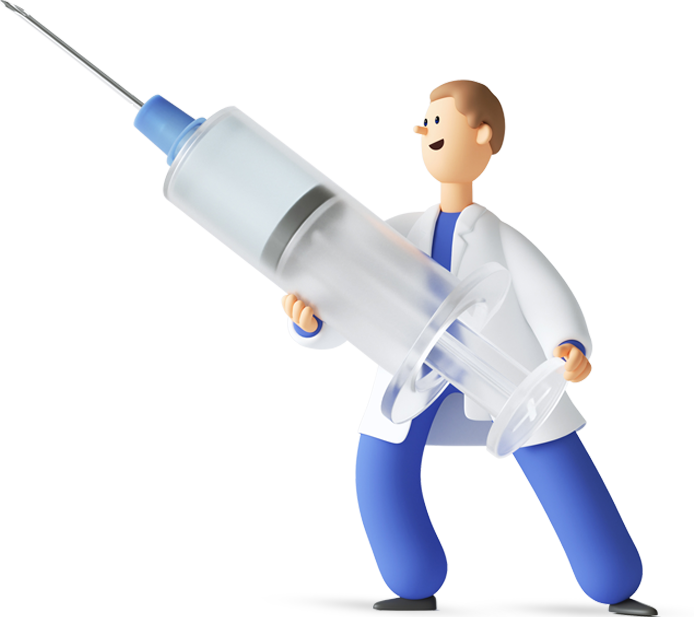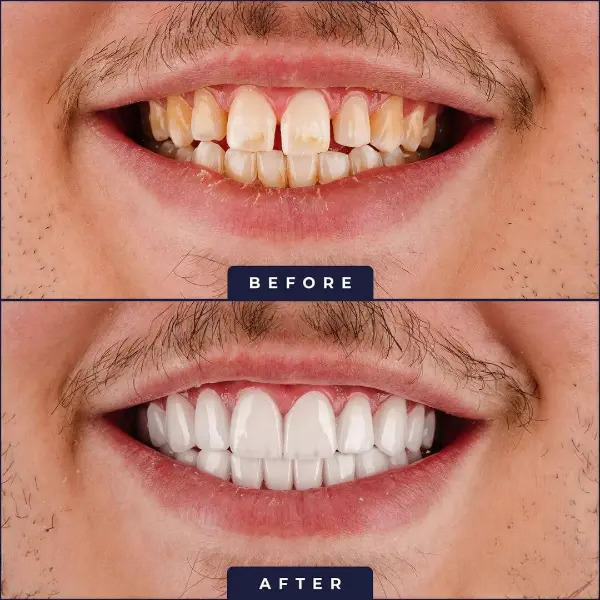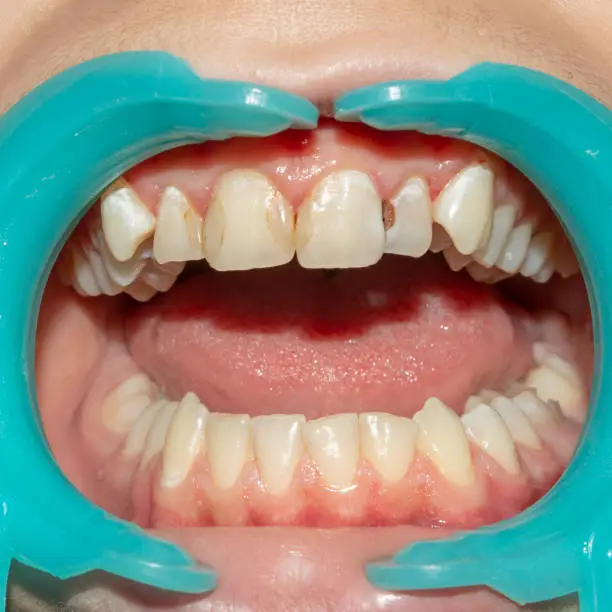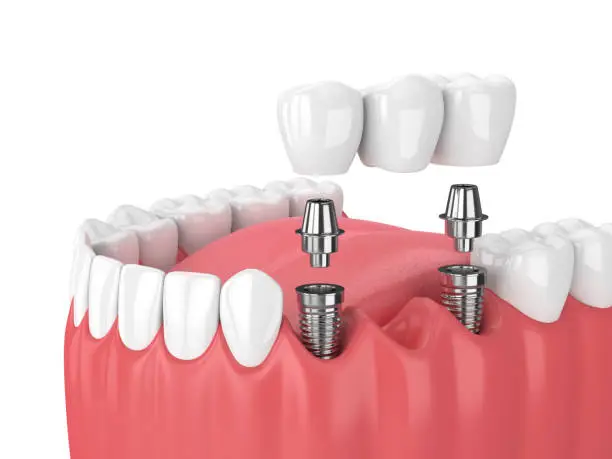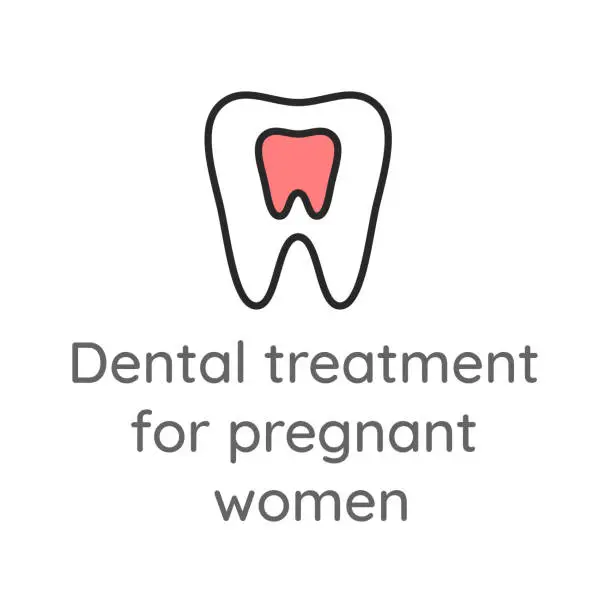Dental Veneers; called porcelain veneers or dental porcelain laminates. Wafer-thin, custom-made shells of tooth-colored materials, designed to cover the front surface of teeth and improve your appearance, bond to your teeth, changing their color, shape, size, or length. People can make them from porcelain or resin composite, but porcelain veneers resist stains better than resin composite and better mimic the light reflecting properties of natural teeth. Composite Dental Veneers Composite veneer is the application of composite resin material to the existing tooth. Dentists use bonding to fill cavities, mask discolored teeth, whiten, repair fractures, and make cosmetic improvements to the natural tooth, usually in one appointment. Cosmetic tooth bonding uses of the composite resin to fix chipped cracked, spaced, or uneven teeth. The resin is applied to the etched natural tooth to achieve the desired esthetic effect. Very little natural . tooth reduction is necessary and usually no anesthesia is needed. Maintaining Bonded Teeth Professionals bond teeth, and they last 5-8 years or longer, requiring finishing once every few years. Tips for maintaining your bonded teeth include: using a nightguard. refrain from smoking. have your teeth cleaned three or four times a year. avoid chewing ice or biting fingernails. and minimize your consumption of stain-causing food and drink. Veneers are routinely used to fix: Discolored teeth Due to RCT, tetracycline, excessive fluoride or other causes. Broken and chipped teeth. Teeth that are worn down. Malaligned, uneven or irregular shaped teeth. Spaced teeth. veneering process *One or more teeth can undergo the veneering process: 1. Diagnosis and treatment planning It includes examination, impressions, explaining the procedure and the expected outcomes. 2. Preparation The dentist removes 0.5 mm of the enamel, then he takes an impression of your teeth. Temporary dental veneers placed until the next visit. 3. Bonding Before cementing the veneers, the dentist will check them in your mouth. Then, if everything is good, he will clean and polish your teeth, and etch them. After that, he will add special cement and place the veneers on your teeth. 4. Maintenance Follow up visits in a couple of months to check how your gums are responding. European Dental Center; best dental clinic in Jordan provide this information about Dental Veneers.
T-Scan’s digital bite force Add modern technology to dental treatment will not leave a doctor to guess where is the problem. With T-Scan’s digital bite force data, clinicians can pinpoint occlusal interferences, quickly remove them, elimination the need for multiple adjustment appointments and treat patients with greater accuracy than ever before. T-Scan is also a great visual aid that helps patients to better understand their occlusion and the treatments that may be necessary to balance bite forces. T-Scan® provides dynamic occlusal measurement—revealing the level and timing of force on individual teeth and the occlusal stability of the overall bite You just need to bite on the T-scan paper sensor and all your occlusal problem will record and appear at a T-scan screen for all types of teeth.. dental implant , prosthesis(bridge ,crown) and new restoration. *One wonderful thing about the T-Scan’s digital bite force is that it can detect force as well as location; Because force has a profound effect on teeth, ligaments, joints, bone and gingiva, this information could be extremely valuable. The T-Scan can detect a mobile tooth as an initial contact as the tooth is moving and it also can help isolate the contact forces on teeth with wear, abfractions or fractures. European Dental Center; best dental clinic in Jordan provide this information about T-Scan’s digital bite force.
Dental fluorosis is a change in the appearance of the tooth’s enamel. These changes can vary from barely noticeable white spots in mild forms to staining and pitting in the more severe forms. Dental fluorosis only occurs when younger children consume too much fluoride, from any source, over long periods when teeth are developing under the gums. develops dental fluorosis Only children aged 8 years and younger can develop dental fluorosis because this is when permanent teeth are developing under the gums. Once the teeth erupt through the gums and are in the mouth, they can no longer develop fluorosis. The teeth of children older than 8 years, adolescents, and adults cannot develop dental fluorosis. What does dental fluorosis look like? dental fluorosis look like: Very mild and mild forms of fluorosis—teeth have scattered white flecks, occasional white spots, frosty edges, or fine, lacy chalk-like lines. These changes are barely noticeable and difficult to see except by a dental health care professional. Moderate and severe forms of fluorosis—teeth have larger white spots and, in the rare, severe form, rough, pitted surfaces. What are the common sources of fluoride? common sources of fluoride: Toothpaste (if swallowed by young children). Drinking water in fluoridated communities. Beverages and food processed with fluoridated water. Dietary prescription supplements that include fluoride (e.g., tablets or drops). Other professional dental products (e.g., mouth rinses, gels, and foams). What health care and public health professionals can do to reduce the occurrence of fluorosis Counsel parents and caregivers regarding use of fluoride toothpaste by young children Parents or caregivers should be counseled on the use of fluoride toothpaste by young children, especially those younger than 2 years. There is an increased chance for fluorosis for children younger than 6 years, and especially for those younger than 2 years, because they are more likely to swallow the toothpaste than older children. For children younger than 2 years, you should consider the fluoride level in the community drinking water, other sources of fluoride, and factors likely to affect susceptibility to tooth decay when weighing the risk and benefits of using fluoride toothpaste. When assessing the risks and benefits, determine if the child may be at high risk for tooth decay because of factors such as poor hygiene, poor diet, or history of decay in the child, and in their siblings or parents. European Dental Center; best dental clinic in Jordan provide this information about dental fluorosis.
Bad breath, also known as halitosis, is a disturbing and unpleasant problem that all of us were confronted to it one day. In general, awful breath originates from the mouth (85-90%) from the tongue. Reasons for Bad Breath The most common reasons are caused by the food we are eating such as (garlic, cheese, onions, meat). obesity, smoking, and alcohol consumption It’s very normal to have “morning awful respiration; because during the night the mouth is exposed to less oxygen and is inactive. Sometimes after a simple tooth brushing, flossing, or rinsing with a mouthwash the respiration can disappear But sometimes, bad breath can be relentless (chronic bad) to some. People, meaning that regular cleaning are not enough to get rid of it This is a more serious condition, and it can negatively affect the individual’s personal, social, and business relationships, leading to poor self-esteem and increased stress. chronic bad breath The reasons of having a chronic awful respiration are multiple such as: bad restorations. plaque accumulation. periodontal disease. tooth abscess. Cysts. sinusitis gastric problems and much more. This will be determined during your first consultation. We will try to find the real cause of your problem and treat it. European Dental Center; best dental clinic in Jordan provide this information about Bad Breath reasons.
Tips for Brushing Your Teeth for Brushing Your Teeth; Follow these tips: Brushing your teeth for at least two minutes. Be sure to get under the wires. Thread the floss string and push it down under the wires between your brackets. Remember to floss every tooth, even the ones in the far back. Gently clean between brackets (under the wires) with the wire brush to get all the plaque off. Use mouthwash to clean your mouth, it will give you nice breath! Stick to foods that require little to no chewing once you first get braces: applesauce, mashed potatoes, soup. Persuade someone to take you out for milkshakes. Also, stay away from foods such as carrots as the pieces get stuck behind the wire and are a pain to get out. Warnings for Brushing Your Teeth Pay attention to these warnings: Don’t eat hard foods like hard taco shells, ice, nuts, Jolly Ranchers, bagels, chips, and apples and carrots unless cut into tiny bite size pieces. If you do not clean your teeth well enough, you may have squares on your teeth where your braces were so brush well! Be sure to stick to the diet your orthodontist recommends at first. Eventually, you will be able to break the rules every once in a while. Always wear the retainer that the orthodontist gives you when you get you braces off. If you don’t, your teeth will move and you might have to get braces again as an adult. If you eat really chewy foods & candies, they may get stuck underneath your braces, causing brown squares to be where the braces once were. European Dental Center; best dental clinic in Jordan provide this information about Brushing your teeth .
Crown or Bridge. Crowns are dental restorations that cover the entire tooth or dental implants. Crown is essential to protect teeth that have been damaged by significant decay, cavities, fractures, or even after root canal treatment. Crowns can be made from various materials such as ceramic, zirconia, porcelain-fused-to-metal, and gold. How Crowns or Bridges are Made? First, the damaged tooth structure is removed to provide enough space for the porcelain. Then, an impression of the prepared tooth is taken, which our dental laboratory technicians use to construct your crown during the fabrication stage. A temporary crown made of acrylic is then created to protect your tooth. The final crown is shaped to look natural, matching your adjacent teeth. It is then cemented onto your tooth with a special adhesive. Our cosmetic goal is to achieve a crown that appears to emerge from the gum line. Is it Better to Have a Bridge or an Implant? A bridge requires at least two healthy teeth to be anchored, and sometimes the removal of the nerve to replace missing teeth. Dental implants, on the other hand, replace the missing tooth without sacrificing the health of adjacent teeth. The advantage of dental implants is that they preserve the bone they are placed in. With a bridge, some of the bone used to support the tooth will begin to resorb and deteriorate. Dental implants integrate with the jawbone, helping to maintain bone health and integrity. A single implant can be more aesthetic and easier to keep clean than a bridge. Different Types of Crowns There are two main types of crowns, porcelain-fused-to-metal (PFM) crowns, and all-ceramic crowns. PFM crowns are made of a metal inner core covered by a layer of ceramic. Although we use metal underneath the ceramic, we can still match the color of your adjacent teeth and make them look like natural teeth. However, if the gum recedes, which is very common, the metal underneath the crown may show and leave a dark line on the gum. These crowns are primarily a good option for back teeth. All-ceramic crowns or porcelain crowns are used today to provide our patients with the best aesthetic and natural color compared to any other type of crown. They are also referred to for those who have metal allergies. Metal-free crowns are an excellent choice for both front and back teeth. A new type of material called “zirconia” is used to build metal-free crowns or bridges, developed in recent years to increase the strength of all-ceramic crowns. It is stronger than porcelain-fused-to-metal crowns and nearly unbreakable. It is also recommended for people with grinding issues. The most significant advantage of zirconia crowns is their versatility in use for both back and front teeth. European Dental Center; best dental clinic in Jordan provide this information about Crown or Bridge!.
Pregnancy and dental heath Pregnancy and dental heath; For most women, routine dental visits are safe during pregnancy, but be sure to let your dental office know what stage of pregnancy you are in when you make your appointment. Changes in your mouth During pregnancy some women may find they are prone to pregnancy gingivitis mild form of gum disease that causes gums to be red, tender, and sore. You can prevent gingivitis by keeping your teeth clean. Your dentist may recommend more frequent cleanings to help control gingivitis. Diet for Pregnant your diet matters especially vitamins A, C, and D, protein, calcium and phosphorous. While it’s normal for pregnant woman to have the desire to eat more, frequent snacking can be an invitation to tooth decay. When you do snack, choose foods that are low in sugar and nutritious for you and your baby such as raw fruits and vegetables After your baby is born Continue taking care of your mouth and your baby’s mouth, too. Although newborns usually have no visible teeth, most baby teeth begin to appear generally about six months after birth. Begin cleaning your baby’s mouth during the first few days after birth by wiping the gums with a clean, moist gauze pad or washcloth. As soon as teeth appear, decay can occur. European Dental Center; best dental clinic in Jordan provide this information about Pregnancy and dental heath.
